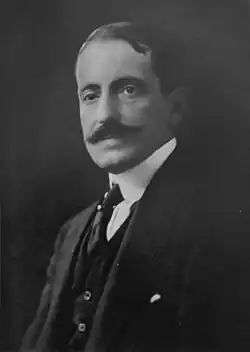Arturo Goyeneche
Arturo Goyeneche | |
|---|---|
 Goyeneche in 1919 | |
| Mayor of Buenos Aires | |
| In office 19 February 1938 – 26 November 1940 | |
| President | Roberto M. Ortiz |
| Preceded by | Mariano de Vedia y Mitre |
| Succeeded by | Raúl Savarese |
| President of the Chamber of Deputies | |
| In office 25 April 1919 – 25 April 1922 | |
| Preceded by | Fernando Saguier |
| Succeeded by | Ricardo Pereyra Rozas |
| Personal details | |
| Born | 4 August 1877 Buenos Aires, Argentina |
| Died | 29 November 1940 (aged 63) Buenos Aires, Argentina |
| Political party | Radical Civic Union |
| Children | Juan Carlos Goyeneche |
Arturo Domingo Goyeneche (4 August 1877 – 29 November 1940) was an Argentine lawyer and politician who served as intendente (mayor) of the City of Buenos Aires from 1938 to 1940, appointed by President Roberto M. Ortiz. A member of the Radical Civic Union (UCR), Goyeneche also served as president of the National Chamber of Deputies, the lower house of Argentina's National Congress.
Early life
Goyeneche was born on 4 August 1877 in Recoleta, Buenos Aires into a family of Basque background.[1]
Political career
During the late 1910s and early 1920s he served as a member of the National Chamber of Deputies, representing the Federal Capital. On 25 April 1919 he was elected by his peers to preside the Chamber, a position he held until 1922.[2]
During the 1930s, he began consolidating political power in southern Buenos Aires through relationships with local ward bosses ("punteros"). His network extended to figures controlling brothels in the portside neighborhood of La Boca, forging an unusual alliance between UCR factions and British company-aligned strike-breaking enforcers. This period marked the development of his controversial political machine that blended formal party politics with underworld connections.[3]
He was a founding member of the Argentine Olympic Committee and served in its first executive board.[4] He provided financial support to Club Atlético Boca Juniors for their landmark acquisition of land on Brandsen Street; this strategic purchase enabled the construction of what would become the iconic Alberto J. Armando Stadium, colloquially known as "La Bombonera", one of world football's most famous venues.
In recognition of this pivotal support during the club's formative years, Boca Juniors granted him honorary membership status.[5]
Mayor of Buenos Aires
Upon the election of Roberto Marcelino Ortiz as President of Argentina on 18 February 1938, Goyeneche was appointed as Mayor of Buenos Aires, succeeding Mariano de Vedia y Mitre.[6] As mayor, he notably vetoed a proposed ordinance that would have demolished the Obelisco de Buenos Aires, then a newly inaugurated but publicly unpopular monument.[7] His administration acquired new lands in 1939 for hospital expansion, though these were soon sold at less than 10% of their value to private developers. These suspicious transactions prompted investigations into corruption networks involving President Ortiz's circle and Buenos Aires UCR politicians. The land deals became emblematic of the Infamous Decade's commonplace corruption.[8]
He died on 26 November 1940, three days after his resignation as mayor.[5] He was replaced in interim fashion by councilman Raúl Savarese, before the appointment of Carlos Alberto Pueyrredón.
Personal life
Goyeneche was interred in the family mausoleum at La Recoleta Cemetery. His political legacy remains complicated by his son Juan Carlos' later affiliation with Nazi-aligned movements during the 1940s.[9]
References
- ^ Beramendi, Jorge (2023). Los vascos en La Recoleta. Guía de sus bóvedas (PDF) (in Spanish). Fundación Vasco Argentina Juan de Garay. p. 49.
- ^ Yaverovski, Alejandro Martín (June 2021). "Tres Repúblicas Barriales y sus Universidades. Las Universidades Populares en la ciudad de Buenos Aires en el período de entreguerras: un esquema preliminar" [Three Neighborhood Republics and their Universities. People's Universities in the city of Buenos Aires in the interwar period: a preliminary outline]. Historia Caribe (in Spanish). 16 (38). Barranquilla: University of Atlántico: 35-80. doi:10.15648/hc.38.2021.2817. ISSN 0122-8803.
- ^ Barovero, Diego Alberto (2023). Caudillos y protagonistas políticos en la Boca del Riachuelo. A 150 años de su autonomía (in Spanish). Buenos Aires: Dunken. ISBN 9789878509310.
- ^ Aguilera, Rubén Pedro (2018). Orígenes del atletismo argentino (PDF) (in Spanish).
- ^ a b "Arturo Goyeneche". Efemérides Radicales (in Spanish). Retrieved 16 July 2025.
- ^ del Corro, Fernando (29 December 2011). "Hace 75 años se consumó el negociado de la Chade". Ámbito Financiero (in Spanish). Retrieved 15 July 2025.
- ^ Pignatelli, Adrián (23 May 2023). "El Obelisco cumple 87 años: la historia del monumento que fue construido donde se izó por primera vez la bandera argentina". Infobae (in Spanish). Retrieved 14 July 2025.
- ^ Visillac, Enrique F. (2017). Pioneros de la salud (in Spanish). Buenos Aires: Olmo Ediciones. p. 135. ISBN 978-987-1555-80-2.
- ^ Goñi, Uki (2022). The Real Odessa. Granta Books. p. 2. ISBN 9781783789252.